Advance Care Practice and Patient Autonomy
VerifiedAdded on 2022/12/23
|10
|2976
|2
AI Summary
Explore the concept of advance care practice and patient autonomy in end-of-life care. Learn about the importance of advance care planning and how it allows patients to make decisions about their future healthcare preferences. Discover the case scenario of Melissa, a woman diagnosed with stage 4 bowel cancer, and how advance care planning can benefit her and her family. Gain insights into the ethical and legal aspects of patient autonomy and the right to choose the time and place of death.
Contribute Materials
Your contribution can guide someone’s learning journey. Share your
documents today.
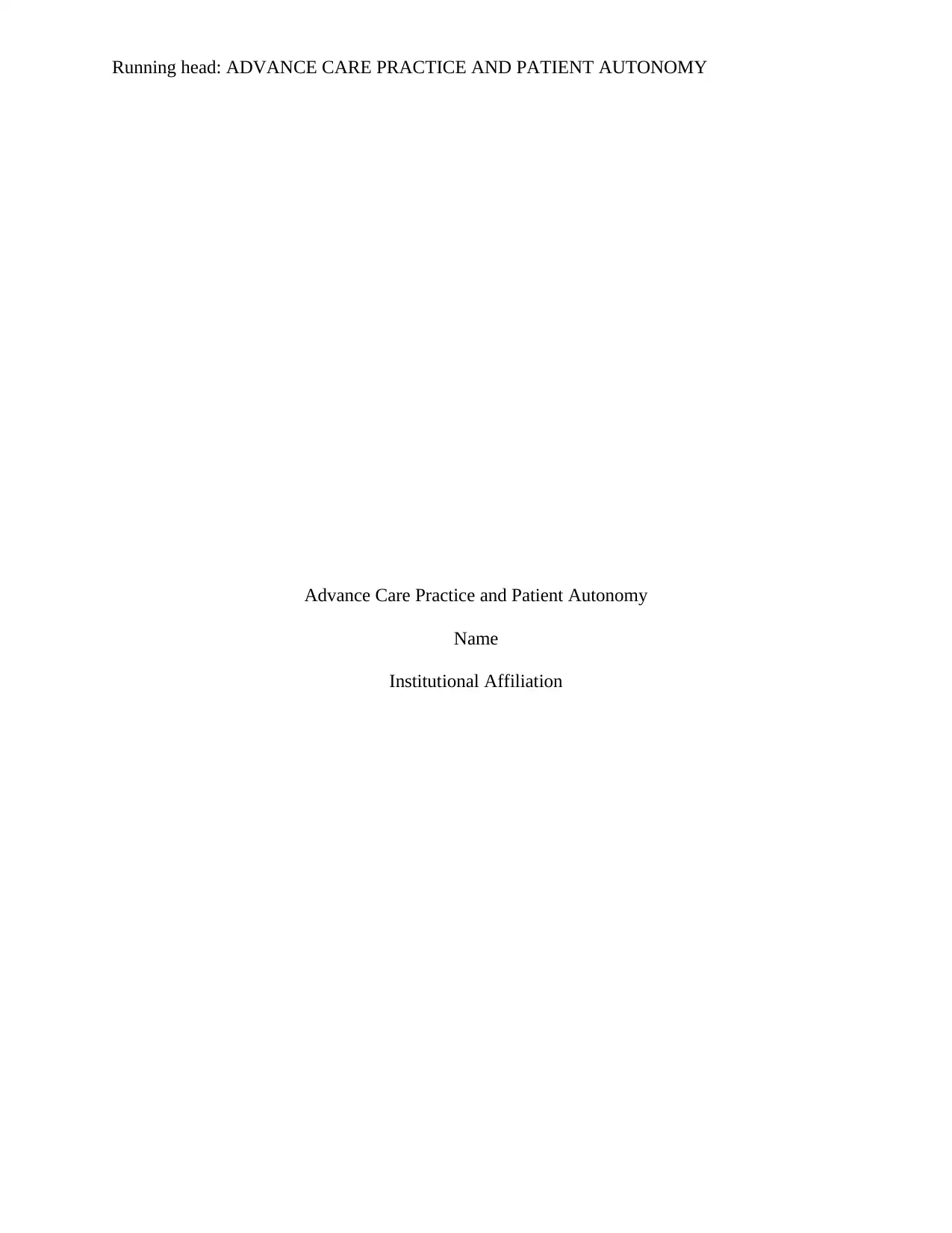
Running head: ADVANCE CARE PRACTICE AND PATIENT AUTONOMY
Advance Care Practice and Patient Autonomy
Name
Institutional Affiliation
Advance Care Practice and Patient Autonomy
Name
Institutional Affiliation
Secure Best Marks with AI Grader
Need help grading? Try our AI Grader for instant feedback on your assignments.
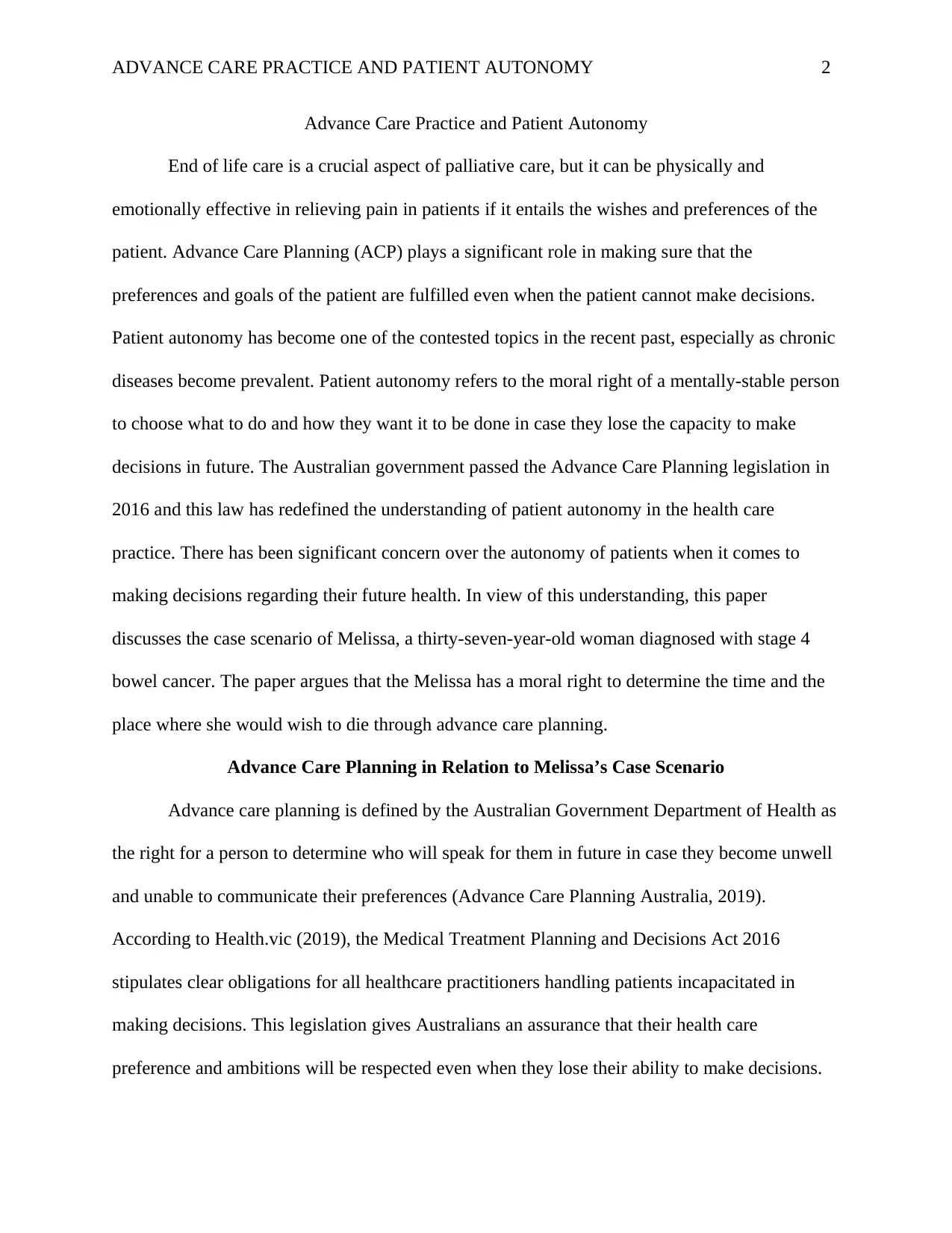
ADVANCE CARE PRACTICE AND PATIENT AUTONOMY 2
Advance Care Practice and Patient Autonomy
End of life care is a crucial aspect of palliative care, but it can be physically and
emotionally effective in relieving pain in patients if it entails the wishes and preferences of the
patient. Advance Care Planning (ACP) plays a significant role in making sure that the
preferences and goals of the patient are fulfilled even when the patient cannot make decisions.
Patient autonomy has become one of the contested topics in the recent past, especially as chronic
diseases become prevalent. Patient autonomy refers to the moral right of a mentally-stable person
to choose what to do and how they want it to be done in case they lose the capacity to make
decisions in future. The Australian government passed the Advance Care Planning legislation in
2016 and this law has redefined the understanding of patient autonomy in the health care
practice. There has been significant concern over the autonomy of patients when it comes to
making decisions regarding their future health. In view of this understanding, this paper
discusses the case scenario of Melissa, a thirty-seven-year-old woman diagnosed with stage 4
bowel cancer. The paper argues that the Melissa has a moral right to determine the time and the
place where she would wish to die through advance care planning.
Advance Care Planning in Relation to Melissa’s Case Scenario
Advance care planning is defined by the Australian Government Department of Health as
the right for a person to determine who will speak for them in future in case they become unwell
and unable to communicate their preferences (Advance Care Planning Australia, 2019).
According to Health.vic (2019), the Medical Treatment Planning and Decisions Act 2016
stipulates clear obligations for all healthcare practitioners handling patients incapacitated in
making decisions. This legislation gives Australians an assurance that their health care
preference and ambitions will be respected even when they lose their ability to make decisions.
Advance Care Practice and Patient Autonomy
End of life care is a crucial aspect of palliative care, but it can be physically and
emotionally effective in relieving pain in patients if it entails the wishes and preferences of the
patient. Advance Care Planning (ACP) plays a significant role in making sure that the
preferences and goals of the patient are fulfilled even when the patient cannot make decisions.
Patient autonomy has become one of the contested topics in the recent past, especially as chronic
diseases become prevalent. Patient autonomy refers to the moral right of a mentally-stable person
to choose what to do and how they want it to be done in case they lose the capacity to make
decisions in future. The Australian government passed the Advance Care Planning legislation in
2016 and this law has redefined the understanding of patient autonomy in the health care
practice. There has been significant concern over the autonomy of patients when it comes to
making decisions regarding their future health. In view of this understanding, this paper
discusses the case scenario of Melissa, a thirty-seven-year-old woman diagnosed with stage 4
bowel cancer. The paper argues that the Melissa has a moral right to determine the time and the
place where she would wish to die through advance care planning.
Advance Care Planning in Relation to Melissa’s Case Scenario
Advance care planning is defined by the Australian Government Department of Health as
the right for a person to determine who will speak for them in future in case they become unwell
and unable to communicate their preferences (Advance Care Planning Australia, 2019).
According to Health.vic (2019), the Medical Treatment Planning and Decisions Act 2016
stipulates clear obligations for all healthcare practitioners handling patients incapacitated in
making decisions. This legislation gives Australians an assurance that their health care
preference and ambitions will be respected even when they lose their ability to make decisions.
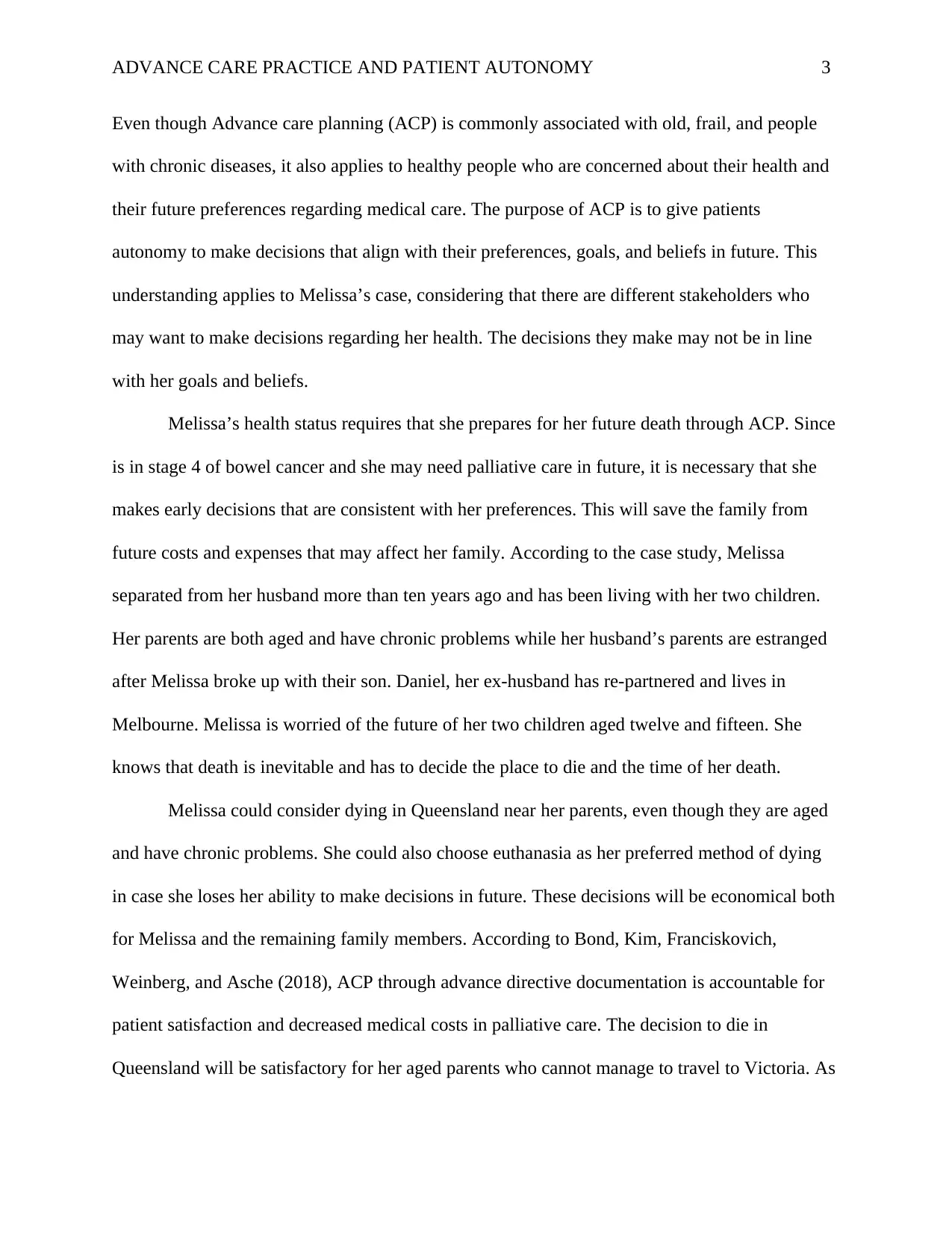
ADVANCE CARE PRACTICE AND PATIENT AUTONOMY 3
Even though Advance care planning (ACP) is commonly associated with old, frail, and people
with chronic diseases, it also applies to healthy people who are concerned about their health and
their future preferences regarding medical care. The purpose of ACP is to give patients
autonomy to make decisions that align with their preferences, goals, and beliefs in future. This
understanding applies to Melissa’s case, considering that there are different stakeholders who
may want to make decisions regarding her health. The decisions they make may not be in line
with her goals and beliefs.
Melissa’s health status requires that she prepares for her future death through ACP. Since
is in stage 4 of bowel cancer and she may need palliative care in future, it is necessary that she
makes early decisions that are consistent with her preferences. This will save the family from
future costs and expenses that may affect her family. According to the case study, Melissa
separated from her husband more than ten years ago and has been living with her two children.
Her parents are both aged and have chronic problems while her husband’s parents are estranged
after Melissa broke up with their son. Daniel, her ex-husband has re-partnered and lives in
Melbourne. Melissa is worried of the future of her two children aged twelve and fifteen. She
knows that death is inevitable and has to decide the place to die and the time of her death.
Melissa could consider dying in Queensland near her parents, even though they are aged
and have chronic problems. She could also choose euthanasia as her preferred method of dying
in case she loses her ability to make decisions in future. These decisions will be economical both
for Melissa and the remaining family members. According to Bond, Kim, Franciskovich,
Weinberg, and Asche (2018), ACP through advance directive documentation is accountable for
patient satisfaction and decreased medical costs in palliative care. The decision to die in
Queensland will be satisfactory for her aged parents who cannot manage to travel to Victoria. As
Even though Advance care planning (ACP) is commonly associated with old, frail, and people
with chronic diseases, it also applies to healthy people who are concerned about their health and
their future preferences regarding medical care. The purpose of ACP is to give patients
autonomy to make decisions that align with their preferences, goals, and beliefs in future. This
understanding applies to Melissa’s case, considering that there are different stakeholders who
may want to make decisions regarding her health. The decisions they make may not be in line
with her goals and beliefs.
Melissa’s health status requires that she prepares for her future death through ACP. Since
is in stage 4 of bowel cancer and she may need palliative care in future, it is necessary that she
makes early decisions that are consistent with her preferences. This will save the family from
future costs and expenses that may affect her family. According to the case study, Melissa
separated from her husband more than ten years ago and has been living with her two children.
Her parents are both aged and have chronic problems while her husband’s parents are estranged
after Melissa broke up with their son. Daniel, her ex-husband has re-partnered and lives in
Melbourne. Melissa is worried of the future of her two children aged twelve and fifteen. She
knows that death is inevitable and has to decide the place to die and the time of her death.
Melissa could consider dying in Queensland near her parents, even though they are aged
and have chronic problems. She could also choose euthanasia as her preferred method of dying
in case she loses her ability to make decisions in future. These decisions will be economical both
for Melissa and the remaining family members. According to Bond, Kim, Franciskovich,
Weinberg, and Asche (2018), ACP through advance directive documentation is accountable for
patient satisfaction and decreased medical costs in palliative care. The decision to die in
Queensland will be satisfactory for her aged parents who cannot manage to travel to Victoria. As
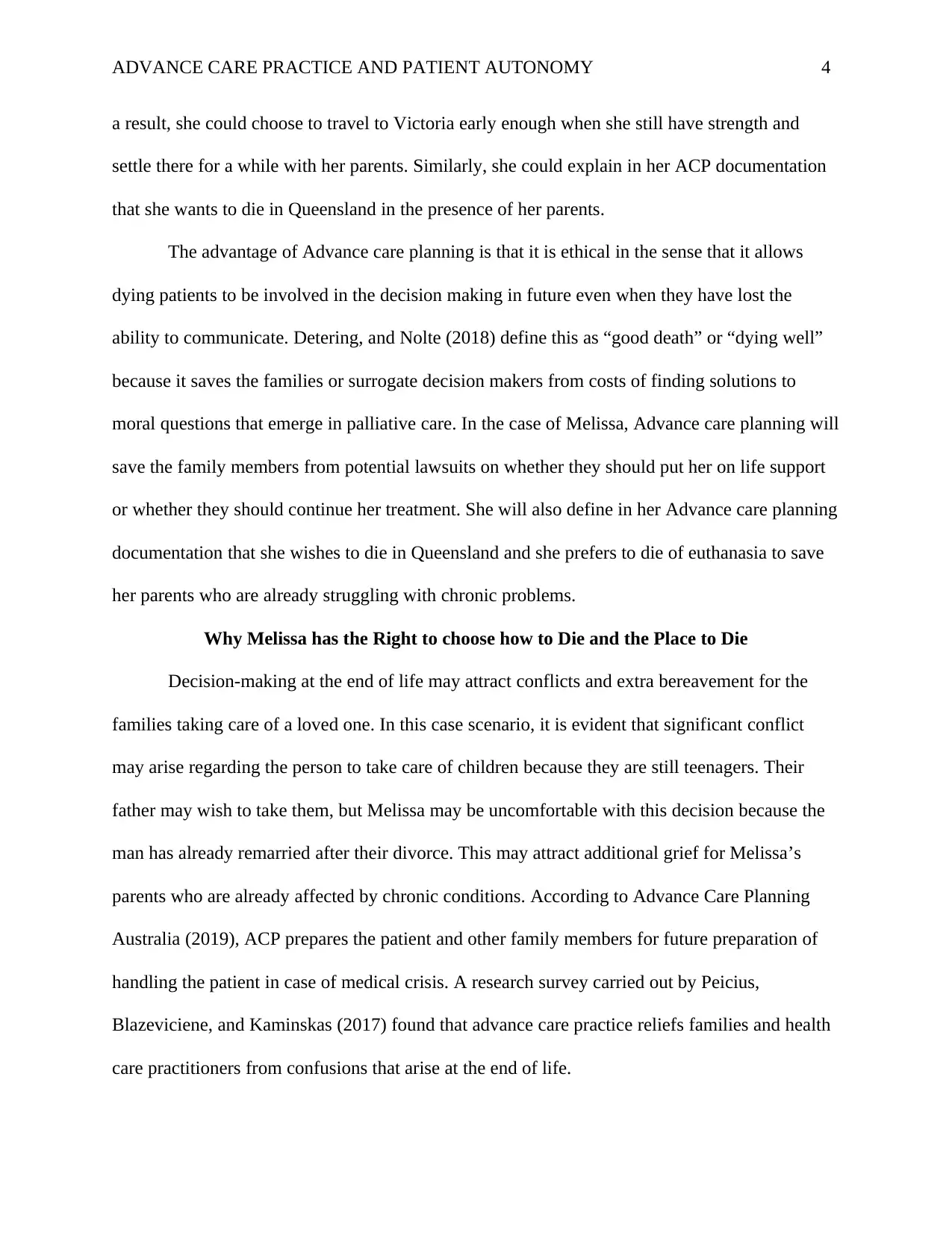
ADVANCE CARE PRACTICE AND PATIENT AUTONOMY 4
a result, she could choose to travel to Victoria early enough when she still have strength and
settle there for a while with her parents. Similarly, she could explain in her ACP documentation
that she wants to die in Queensland in the presence of her parents.
The advantage of Advance care planning is that it is ethical in the sense that it allows
dying patients to be involved in the decision making in future even when they have lost the
ability to communicate. Detering, and Nolte (2018) define this as “good death” or “dying well”
because it saves the families or surrogate decision makers from costs of finding solutions to
moral questions that emerge in palliative care. In the case of Melissa, Advance care planning will
save the family members from potential lawsuits on whether they should put her on life support
or whether they should continue her treatment. She will also define in her Advance care planning
documentation that she wishes to die in Queensland and she prefers to die of euthanasia to save
her parents who are already struggling with chronic problems.
Why Melissa has the Right to choose how to Die and the Place to Die
Decision-making at the end of life may attract conflicts and extra bereavement for the
families taking care of a loved one. In this case scenario, it is evident that significant conflict
may arise regarding the person to take care of children because they are still teenagers. Their
father may wish to take them, but Melissa may be uncomfortable with this decision because the
man has already remarried after their divorce. This may attract additional grief for Melissa’s
parents who are already affected by chronic conditions. According to Advance Care Planning
Australia (2019), ACP prepares the patient and other family members for future preparation of
handling the patient in case of medical crisis. A research survey carried out by Peicius,
Blazeviciene, and Kaminskas (2017) found that advance care practice reliefs families and health
care practitioners from confusions that arise at the end of life.
a result, she could choose to travel to Victoria early enough when she still have strength and
settle there for a while with her parents. Similarly, she could explain in her ACP documentation
that she wants to die in Queensland in the presence of her parents.
The advantage of Advance care planning is that it is ethical in the sense that it allows
dying patients to be involved in the decision making in future even when they have lost the
ability to communicate. Detering, and Nolte (2018) define this as “good death” or “dying well”
because it saves the families or surrogate decision makers from costs of finding solutions to
moral questions that emerge in palliative care. In the case of Melissa, Advance care planning will
save the family members from potential lawsuits on whether they should put her on life support
or whether they should continue her treatment. She will also define in her Advance care planning
documentation that she wishes to die in Queensland and she prefers to die of euthanasia to save
her parents who are already struggling with chronic problems.
Why Melissa has the Right to choose how to Die and the Place to Die
Decision-making at the end of life may attract conflicts and extra bereavement for the
families taking care of a loved one. In this case scenario, it is evident that significant conflict
may arise regarding the person to take care of children because they are still teenagers. Their
father may wish to take them, but Melissa may be uncomfortable with this decision because the
man has already remarried after their divorce. This may attract additional grief for Melissa’s
parents who are already affected by chronic conditions. According to Advance Care Planning
Australia (2019), ACP prepares the patient and other family members for future preparation of
handling the patient in case of medical crisis. A research survey carried out by Peicius,
Blazeviciene, and Kaminskas (2017) found that advance care practice reliefs families and health
care practitioners from confusions that arise at the end of life.
Secure Best Marks with AI Grader
Need help grading? Try our AI Grader for instant feedback on your assignments.
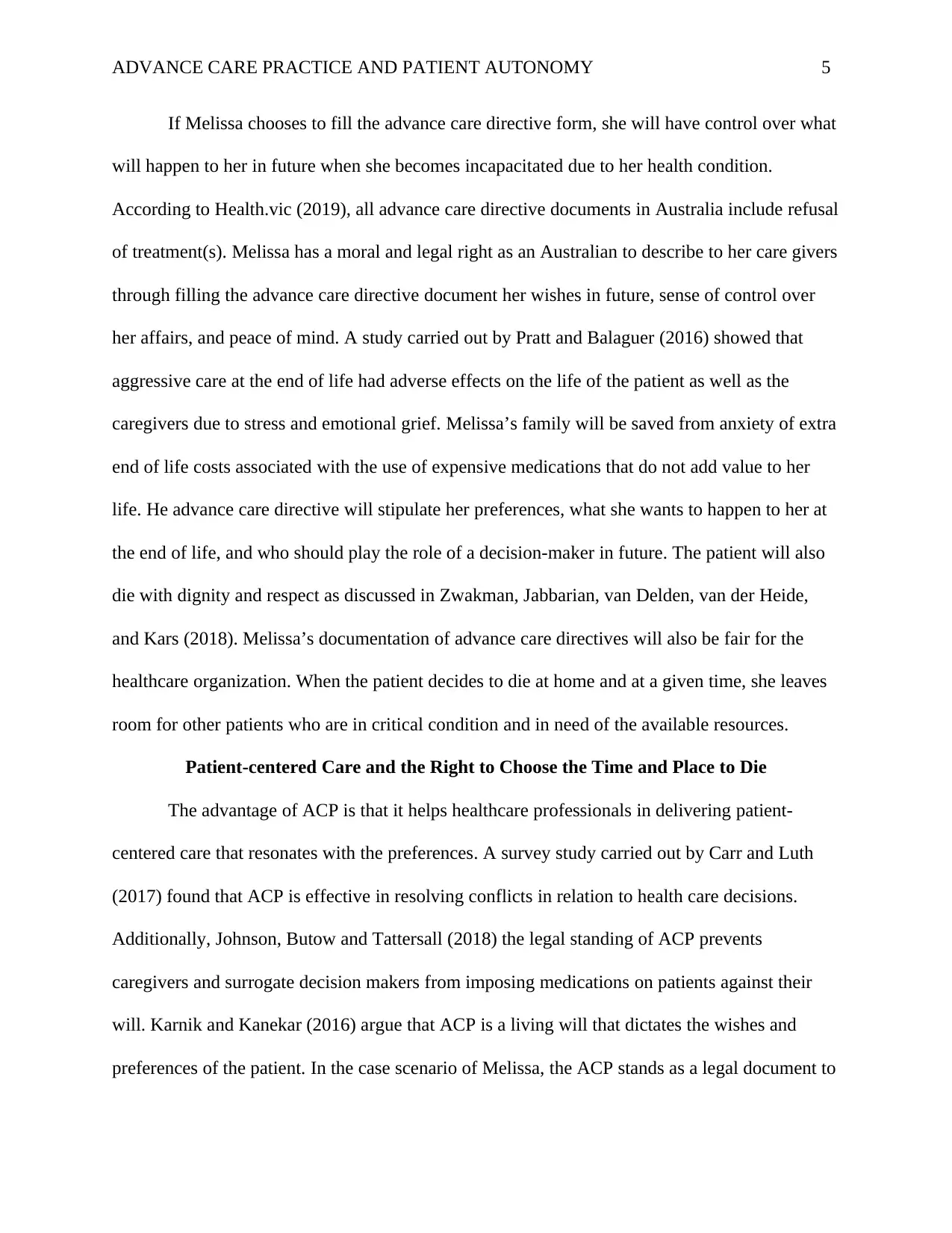
ADVANCE CARE PRACTICE AND PATIENT AUTONOMY 5
If Melissa chooses to fill the advance care directive form, she will have control over what
will happen to her in future when she becomes incapacitated due to her health condition.
According to Health.vic (2019), all advance care directive documents in Australia include refusal
of treatment(s). Melissa has a moral and legal right as an Australian to describe to her care givers
through filling the advance care directive document her wishes in future, sense of control over
her affairs, and peace of mind. A study carried out by Pratt and Balaguer (2016) showed that
aggressive care at the end of life had adverse effects on the life of the patient as well as the
caregivers due to stress and emotional grief. Melissa’s family will be saved from anxiety of extra
end of life costs associated with the use of expensive medications that do not add value to her
life. He advance care directive will stipulate her preferences, what she wants to happen to her at
the end of life, and who should play the role of a decision-maker in future. The patient will also
die with dignity and respect as discussed in Zwakman, Jabbarian, van Delden, van der Heide,
and Kars (2018). Melissa’s documentation of advance care directives will also be fair for the
healthcare organization. When the patient decides to die at home and at a given time, she leaves
room for other patients who are in critical condition and in need of the available resources.
Patient-centered Care and the Right to Choose the Time and Place to Die
The advantage of ACP is that it helps healthcare professionals in delivering patient-
centered care that resonates with the preferences. A survey study carried out by Carr and Luth
(2017) found that ACP is effective in resolving conflicts in relation to health care decisions.
Additionally, Johnson, Butow and Tattersall (2018) the legal standing of ACP prevents
caregivers and surrogate decision makers from imposing medications on patients against their
will. Karnik and Kanekar (2016) argue that ACP is a living will that dictates the wishes and
preferences of the patient. In the case scenario of Melissa, the ACP stands as a legal document to
If Melissa chooses to fill the advance care directive form, she will have control over what
will happen to her in future when she becomes incapacitated due to her health condition.
According to Health.vic (2019), all advance care directive documents in Australia include refusal
of treatment(s). Melissa has a moral and legal right as an Australian to describe to her care givers
through filling the advance care directive document her wishes in future, sense of control over
her affairs, and peace of mind. A study carried out by Pratt and Balaguer (2016) showed that
aggressive care at the end of life had adverse effects on the life of the patient as well as the
caregivers due to stress and emotional grief. Melissa’s family will be saved from anxiety of extra
end of life costs associated with the use of expensive medications that do not add value to her
life. He advance care directive will stipulate her preferences, what she wants to happen to her at
the end of life, and who should play the role of a decision-maker in future. The patient will also
die with dignity and respect as discussed in Zwakman, Jabbarian, van Delden, van der Heide,
and Kars (2018). Melissa’s documentation of advance care directives will also be fair for the
healthcare organization. When the patient decides to die at home and at a given time, she leaves
room for other patients who are in critical condition and in need of the available resources.
Patient-centered Care and the Right to Choose the Time and Place to Die
The advantage of ACP is that it helps healthcare professionals in delivering patient-
centered care that resonates with the preferences. A survey study carried out by Carr and Luth
(2017) found that ACP is effective in resolving conflicts in relation to health care decisions.
Additionally, Johnson, Butow and Tattersall (2018) the legal standing of ACP prevents
caregivers and surrogate decision makers from imposing medications on patients against their
will. Karnik and Kanekar (2016) argue that ACP is a living will that dictates the wishes and
preferences of the patient. In the case scenario of Melissa, the ACP stands as a legal document to
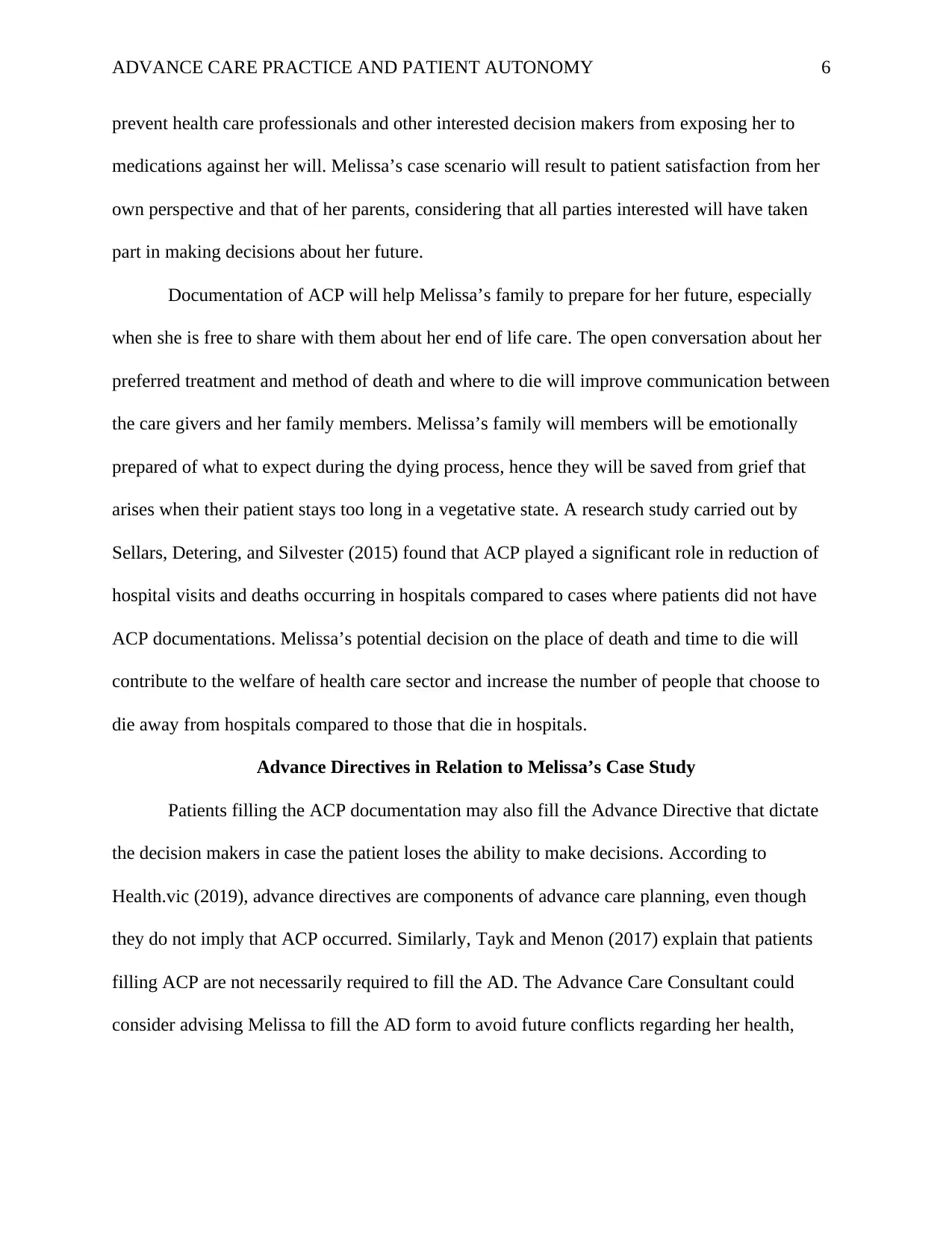
ADVANCE CARE PRACTICE AND PATIENT AUTONOMY 6
prevent health care professionals and other interested decision makers from exposing her to
medications against her will. Melissa’s case scenario will result to patient satisfaction from her
own perspective and that of her parents, considering that all parties interested will have taken
part in making decisions about her future.
Documentation of ACP will help Melissa’s family to prepare for her future, especially
when she is free to share with them about her end of life care. The open conversation about her
preferred treatment and method of death and where to die will improve communication between
the care givers and her family members. Melissa’s family will members will be emotionally
prepared of what to expect during the dying process, hence they will be saved from grief that
arises when their patient stays too long in a vegetative state. A research study carried out by
Sellars, Detering, and Silvester (2015) found that ACP played a significant role in reduction of
hospital visits and deaths occurring in hospitals compared to cases where patients did not have
ACP documentations. Melissa’s potential decision on the place of death and time to die will
contribute to the welfare of health care sector and increase the number of people that choose to
die away from hospitals compared to those that die in hospitals.
Advance Directives in Relation to Melissa’s Case Study
Patients filling the ACP documentation may also fill the Advance Directive that dictate
the decision makers in case the patient loses the ability to make decisions. According to
Health.vic (2019), advance directives are components of advance care planning, even though
they do not imply that ACP occurred. Similarly, Tayk and Menon (2017) explain that patients
filling ACP are not necessarily required to fill the AD. The Advance Care Consultant could
consider advising Melissa to fill the AD form to avoid future conflicts regarding her health,
prevent health care professionals and other interested decision makers from exposing her to
medications against her will. Melissa’s case scenario will result to patient satisfaction from her
own perspective and that of her parents, considering that all parties interested will have taken
part in making decisions about her future.
Documentation of ACP will help Melissa’s family to prepare for her future, especially
when she is free to share with them about her end of life care. The open conversation about her
preferred treatment and method of death and where to die will improve communication between
the care givers and her family members. Melissa’s family will members will be emotionally
prepared of what to expect during the dying process, hence they will be saved from grief that
arises when their patient stays too long in a vegetative state. A research study carried out by
Sellars, Detering, and Silvester (2015) found that ACP played a significant role in reduction of
hospital visits and deaths occurring in hospitals compared to cases where patients did not have
ACP documentations. Melissa’s potential decision on the place of death and time to die will
contribute to the welfare of health care sector and increase the number of people that choose to
die away from hospitals compared to those that die in hospitals.
Advance Directives in Relation to Melissa’s Case Study
Patients filling the ACP documentation may also fill the Advance Directive that dictate
the decision makers in case the patient loses the ability to make decisions. According to
Health.vic (2019), advance directives are components of advance care planning, even though
they do not imply that ACP occurred. Similarly, Tayk and Menon (2017) explain that patients
filling ACP are not necessarily required to fill the AD. The Advance Care Consultant could
consider advising Melissa to fill the AD form to avoid future conflicts regarding her health,
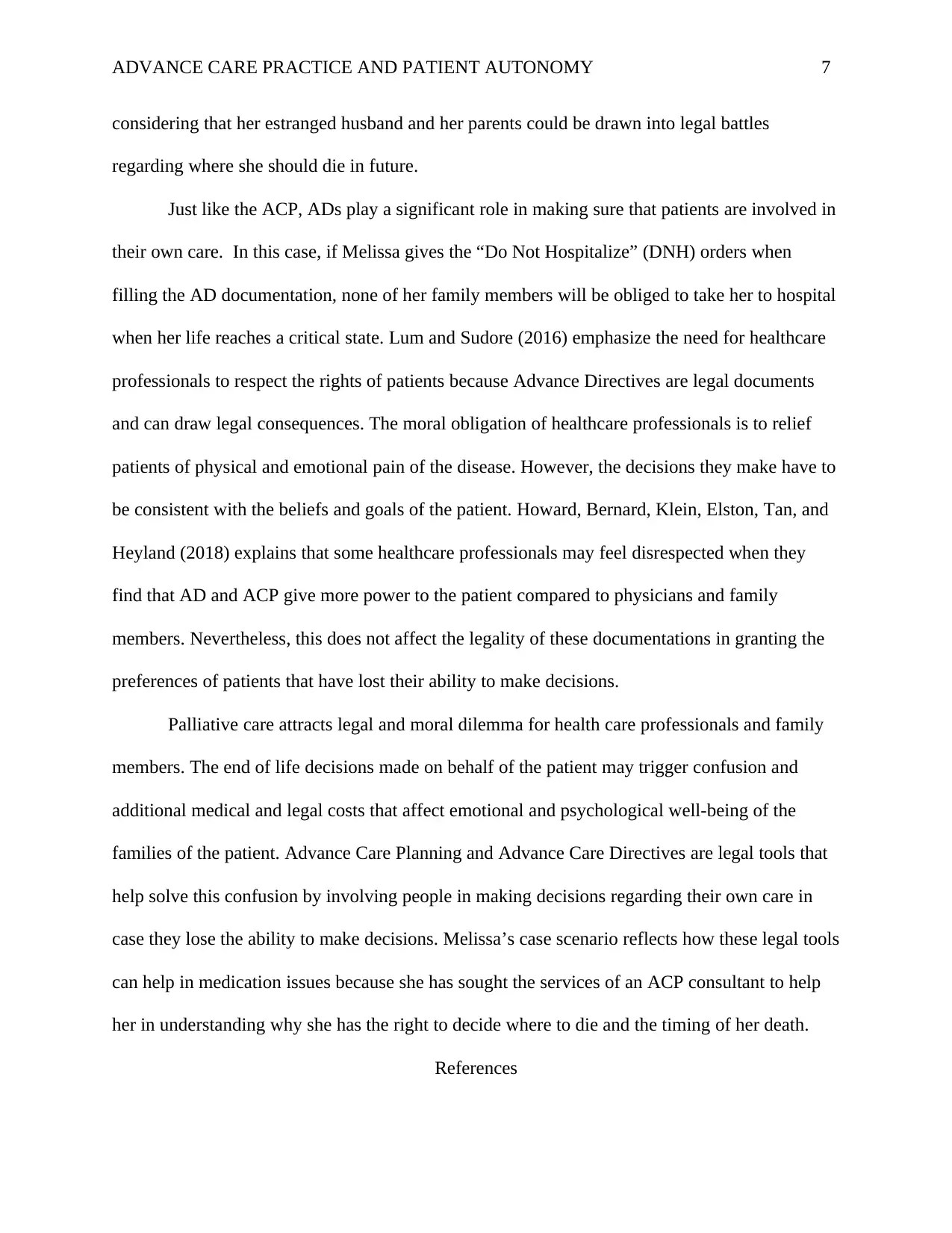
ADVANCE CARE PRACTICE AND PATIENT AUTONOMY 7
considering that her estranged husband and her parents could be drawn into legal battles
regarding where she should die in future.
Just like the ACP, ADs play a significant role in making sure that patients are involved in
their own care. In this case, if Melissa gives the “Do Not Hospitalize” (DNH) orders when
filling the AD documentation, none of her family members will be obliged to take her to hospital
when her life reaches a critical state. Lum and Sudore (2016) emphasize the need for healthcare
professionals to respect the rights of patients because Advance Directives are legal documents
and can draw legal consequences. The moral obligation of healthcare professionals is to relief
patients of physical and emotional pain of the disease. However, the decisions they make have to
be consistent with the beliefs and goals of the patient. Howard, Bernard, Klein, Elston, Tan, and
Heyland (2018) explains that some healthcare professionals may feel disrespected when they
find that AD and ACP give more power to the patient compared to physicians and family
members. Nevertheless, this does not affect the legality of these documentations in granting the
preferences of patients that have lost their ability to make decisions.
Palliative care attracts legal and moral dilemma for health care professionals and family
members. The end of life decisions made on behalf of the patient may trigger confusion and
additional medical and legal costs that affect emotional and psychological well-being of the
families of the patient. Advance Care Planning and Advance Care Directives are legal tools that
help solve this confusion by involving people in making decisions regarding their own care in
case they lose the ability to make decisions. Melissa’s case scenario reflects how these legal tools
can help in medication issues because she has sought the services of an ACP consultant to help
her in understanding why she has the right to decide where to die and the timing of her death.
References
considering that her estranged husband and her parents could be drawn into legal battles
regarding where she should die in future.
Just like the ACP, ADs play a significant role in making sure that patients are involved in
their own care. In this case, if Melissa gives the “Do Not Hospitalize” (DNH) orders when
filling the AD documentation, none of her family members will be obliged to take her to hospital
when her life reaches a critical state. Lum and Sudore (2016) emphasize the need for healthcare
professionals to respect the rights of patients because Advance Directives are legal documents
and can draw legal consequences. The moral obligation of healthcare professionals is to relief
patients of physical and emotional pain of the disease. However, the decisions they make have to
be consistent with the beliefs and goals of the patient. Howard, Bernard, Klein, Elston, Tan, and
Heyland (2018) explains that some healthcare professionals may feel disrespected when they
find that AD and ACP give more power to the patient compared to physicians and family
members. Nevertheless, this does not affect the legality of these documentations in granting the
preferences of patients that have lost their ability to make decisions.
Palliative care attracts legal and moral dilemma for health care professionals and family
members. The end of life decisions made on behalf of the patient may trigger confusion and
additional medical and legal costs that affect emotional and psychological well-being of the
families of the patient. Advance Care Planning and Advance Care Directives are legal tools that
help solve this confusion by involving people in making decisions regarding their own care in
case they lose the ability to make decisions. Melissa’s case scenario reflects how these legal tools
can help in medication issues because she has sought the services of an ACP consultant to help
her in understanding why she has the right to decide where to die and the timing of her death.
References
Paraphrase This Document
Need a fresh take? Get an instant paraphrase of this document with our AI Paraphraser
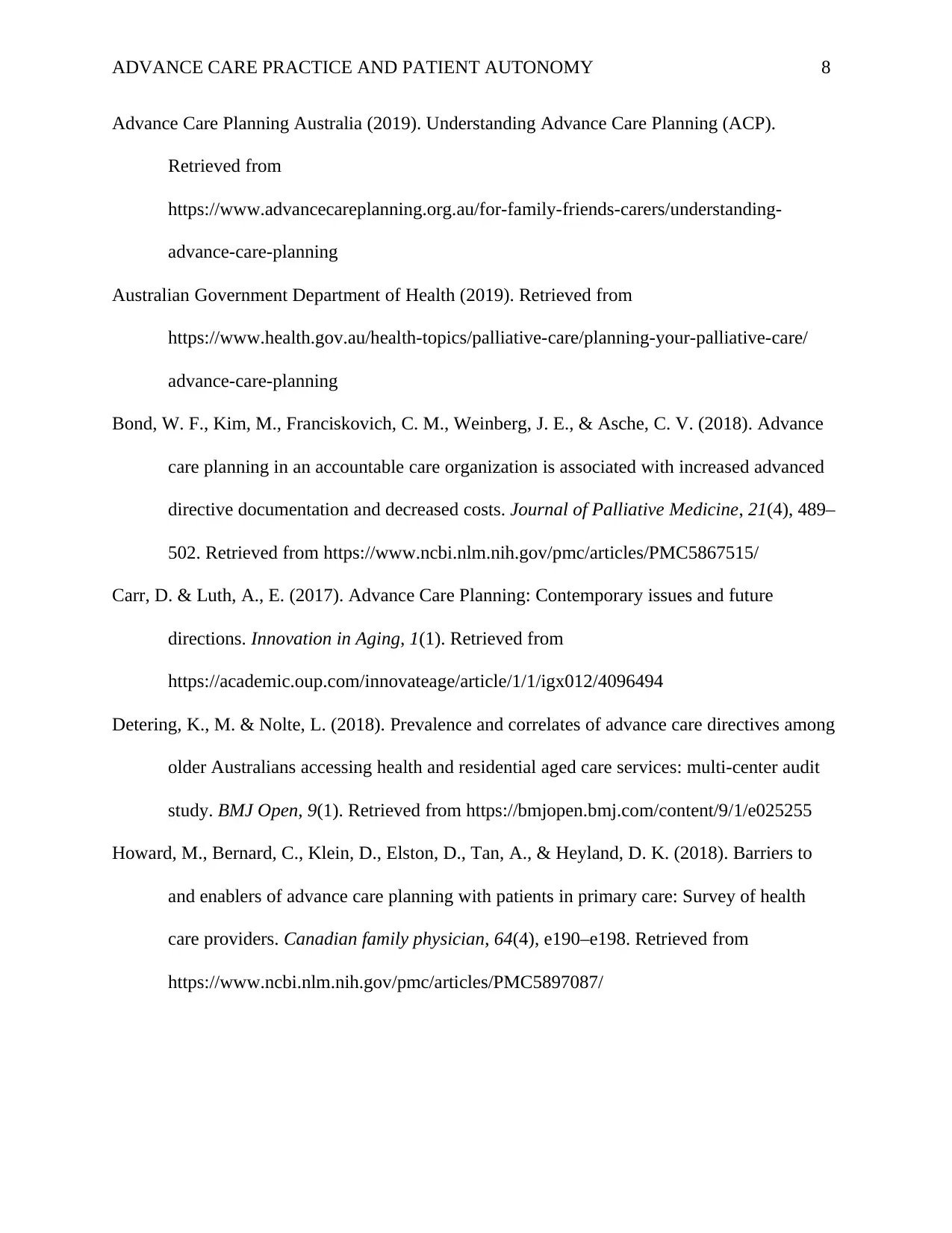
ADVANCE CARE PRACTICE AND PATIENT AUTONOMY 8
Advance Care Planning Australia (2019). Understanding Advance Care Planning (ACP).
Retrieved from
https://www.advancecareplanning.org.au/for-family-friends-carers/understanding-
advance-care-planning
Australian Government Department of Health (2019). Retrieved from
https://www.health.gov.au/health-topics/palliative-care/planning-your-palliative-care/
advance-care-planning
Bond, W. F., Kim, M., Franciskovich, C. M., Weinberg, J. E., & Asche, C. V. (2018). Advance
care planning in an accountable care organization is associated with increased advanced
directive documentation and decreased costs. Journal of Palliative Medicine, 21(4), 489–
502. Retrieved from https://www.ncbi.nlm.nih.gov/pmc/articles/PMC5867515/
Carr, D. & Luth, A., E. (2017). Advance Care Planning: Contemporary issues and future
directions. Innovation in Aging, 1(1). Retrieved from
https://academic.oup.com/innovateage/article/1/1/igx012/4096494
Detering, K., M. & Nolte, L. (2018). Prevalence and correlates of advance care directives among
older Australians accessing health and residential aged care services: multi-center audit
study. BMJ Open, 9(1). Retrieved from https://bmjopen.bmj.com/content/9/1/e025255
Howard, M., Bernard, C., Klein, D., Elston, D., Tan, A., & Heyland, D. K. (2018). Barriers to
and enablers of advance care planning with patients in primary care: Survey of health
care providers. Canadian family physician, 64(4), e190–e198. Retrieved from
https://www.ncbi.nlm.nih.gov/pmc/articles/PMC5897087/
Advance Care Planning Australia (2019). Understanding Advance Care Planning (ACP).
Retrieved from
https://www.advancecareplanning.org.au/for-family-friends-carers/understanding-
advance-care-planning
Australian Government Department of Health (2019). Retrieved from
https://www.health.gov.au/health-topics/palliative-care/planning-your-palliative-care/
advance-care-planning
Bond, W. F., Kim, M., Franciskovich, C. M., Weinberg, J. E., & Asche, C. V. (2018). Advance
care planning in an accountable care organization is associated with increased advanced
directive documentation and decreased costs. Journal of Palliative Medicine, 21(4), 489–
502. Retrieved from https://www.ncbi.nlm.nih.gov/pmc/articles/PMC5867515/
Carr, D. & Luth, A., E. (2017). Advance Care Planning: Contemporary issues and future
directions. Innovation in Aging, 1(1). Retrieved from
https://academic.oup.com/innovateage/article/1/1/igx012/4096494
Detering, K., M. & Nolte, L. (2018). Prevalence and correlates of advance care directives among
older Australians accessing health and residential aged care services: multi-center audit
study. BMJ Open, 9(1). Retrieved from https://bmjopen.bmj.com/content/9/1/e025255
Howard, M., Bernard, C., Klein, D., Elston, D., Tan, A., & Heyland, D. K. (2018). Barriers to
and enablers of advance care planning with patients in primary care: Survey of health
care providers. Canadian family physician, 64(4), e190–e198. Retrieved from
https://www.ncbi.nlm.nih.gov/pmc/articles/PMC5897087/
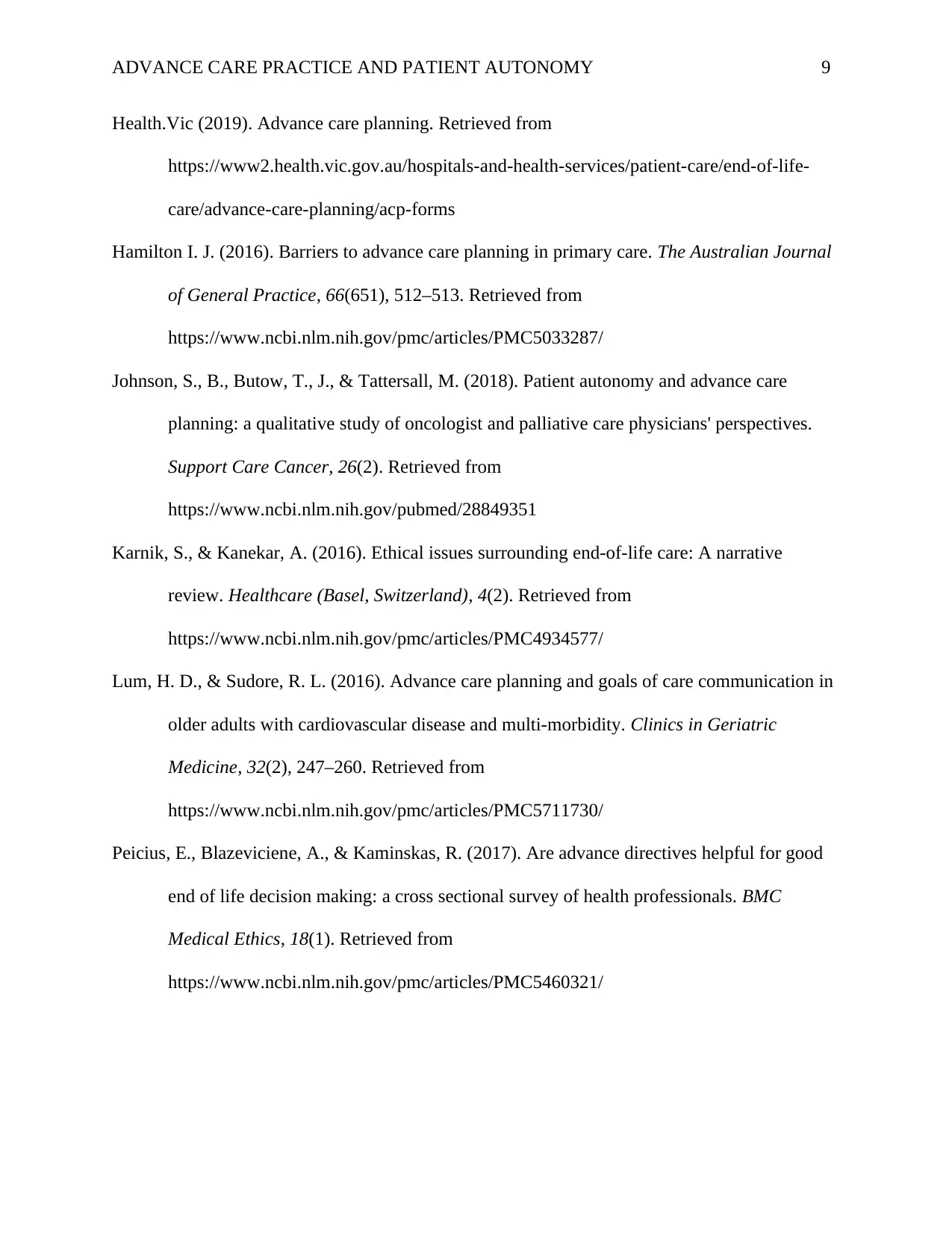
ADVANCE CARE PRACTICE AND PATIENT AUTONOMY 9
Health.Vic (2019). Advance care planning. Retrieved from
https://www2.health.vic.gov.au/hospitals-and-health-services/patient-care/end-of-life-
care/advance-care-planning/acp-forms
Hamilton I. J. (2016). Barriers to advance care planning in primary care. The Australian Journal
of General Practice, 66(651), 512–513. Retrieved from
https://www.ncbi.nlm.nih.gov/pmc/articles/PMC5033287/
Johnson, S., B., Butow, T., J., & Tattersall, M. (2018). Patient autonomy and advance care
planning: a qualitative study of oncologist and palliative care physicians' perspectives.
Support Care Cancer, 26(2). Retrieved from
https://www.ncbi.nlm.nih.gov/pubmed/28849351
Karnik, S., & Kanekar, A. (2016). Ethical issues surrounding end-of-life care: A narrative
review. Healthcare (Basel, Switzerland), 4(2). Retrieved from
https://www.ncbi.nlm.nih.gov/pmc/articles/PMC4934577/
Lum, H. D., & Sudore, R. L. (2016). Advance care planning and goals of care communication in
older adults with cardiovascular disease and multi-morbidity. Clinics in Geriatric
Medicine, 32(2), 247–260. Retrieved from
https://www.ncbi.nlm.nih.gov/pmc/articles/PMC5711730/
Peicius, E., Blazeviciene, A., & Kaminskas, R. (2017). Are advance directives helpful for good
end of life decision making: a cross sectional survey of health professionals. BMC
Medical Ethics, 18(1). Retrieved from
https://www.ncbi.nlm.nih.gov/pmc/articles/PMC5460321/
Health.Vic (2019). Advance care planning. Retrieved from
https://www2.health.vic.gov.au/hospitals-and-health-services/patient-care/end-of-life-
care/advance-care-planning/acp-forms
Hamilton I. J. (2016). Barriers to advance care planning in primary care. The Australian Journal
of General Practice, 66(651), 512–513. Retrieved from
https://www.ncbi.nlm.nih.gov/pmc/articles/PMC5033287/
Johnson, S., B., Butow, T., J., & Tattersall, M. (2018). Patient autonomy and advance care
planning: a qualitative study of oncologist and palliative care physicians' perspectives.
Support Care Cancer, 26(2). Retrieved from
https://www.ncbi.nlm.nih.gov/pubmed/28849351
Karnik, S., & Kanekar, A. (2016). Ethical issues surrounding end-of-life care: A narrative
review. Healthcare (Basel, Switzerland), 4(2). Retrieved from
https://www.ncbi.nlm.nih.gov/pmc/articles/PMC4934577/
Lum, H. D., & Sudore, R. L. (2016). Advance care planning and goals of care communication in
older adults with cardiovascular disease and multi-morbidity. Clinics in Geriatric
Medicine, 32(2), 247–260. Retrieved from
https://www.ncbi.nlm.nih.gov/pmc/articles/PMC5711730/
Peicius, E., Blazeviciene, A., & Kaminskas, R. (2017). Are advance directives helpful for good
end of life decision making: a cross sectional survey of health professionals. BMC
Medical Ethics, 18(1). Retrieved from
https://www.ncbi.nlm.nih.gov/pmc/articles/PMC5460321/
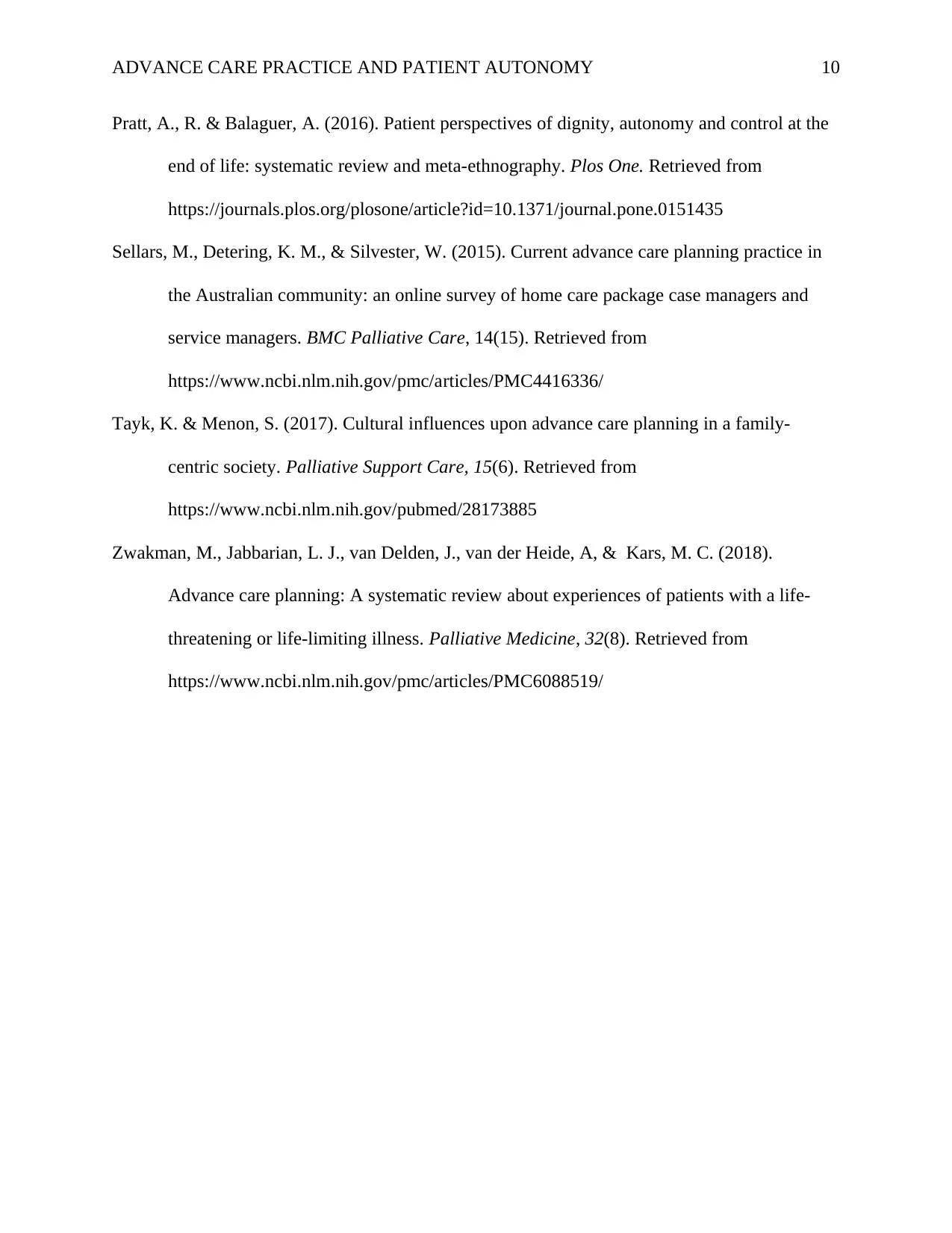
ADVANCE CARE PRACTICE AND PATIENT AUTONOMY 10
Pratt, A., R. & Balaguer, A. (2016). Patient perspectives of dignity, autonomy and control at the
end of life: systematic review and meta-ethnography. Plos One. Retrieved from
https://journals.plos.org/plosone/article?id=10.1371/journal.pone.0151435
Sellars, M., Detering, K. M., & Silvester, W. (2015). Current advance care planning practice in
the Australian community: an online survey of home care package case managers and
service managers. BMC Palliative Care, 14(15). Retrieved from
https://www.ncbi.nlm.nih.gov/pmc/articles/PMC4416336/
Tayk, K. & Menon, S. (2017). Cultural influences upon advance care planning in a family-
centric society. Palliative Support Care, 15(6). Retrieved from
https://www.ncbi.nlm.nih.gov/pubmed/28173885
Zwakman, M., Jabbarian, L. J., van Delden, J., van der Heide, A, & Kars, M. C. (2018).
Advance care planning: A systematic review about experiences of patients with a life-
threatening or life-limiting illness. Palliative Medicine, 32(8). Retrieved from
https://www.ncbi.nlm.nih.gov/pmc/articles/PMC6088519/
Pratt, A., R. & Balaguer, A. (2016). Patient perspectives of dignity, autonomy and control at the
end of life: systematic review and meta-ethnography. Plos One. Retrieved from
https://journals.plos.org/plosone/article?id=10.1371/journal.pone.0151435
Sellars, M., Detering, K. M., & Silvester, W. (2015). Current advance care planning practice in
the Australian community: an online survey of home care package case managers and
service managers. BMC Palliative Care, 14(15). Retrieved from
https://www.ncbi.nlm.nih.gov/pmc/articles/PMC4416336/
Tayk, K. & Menon, S. (2017). Cultural influences upon advance care planning in a family-
centric society. Palliative Support Care, 15(6). Retrieved from
https://www.ncbi.nlm.nih.gov/pubmed/28173885
Zwakman, M., Jabbarian, L. J., van Delden, J., van der Heide, A, & Kars, M. C. (2018).
Advance care planning: A systematic review about experiences of patients with a life-
threatening or life-limiting illness. Palliative Medicine, 32(8). Retrieved from
https://www.ncbi.nlm.nih.gov/pmc/articles/PMC6088519/
1 out of 10
Related Documents
Your All-in-One AI-Powered Toolkit for Academic Success.
+13062052269
info@desklib.com
Available 24*7 on WhatsApp / Email
![[object Object]](/_next/static/media/star-bottom.7253800d.svg)
Unlock your academic potential
© 2024 | Zucol Services PVT LTD | All rights reserved.





